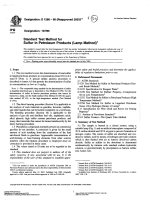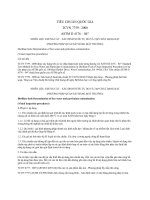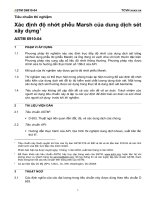Astm d 5593 99e1
Bạn đang xem bản rút gọn của tài liệu. Xem và tải ngay bản đầy đủ của tài liệu tại đây (47.34 KB, 4 trang )
Designation: D 5593 – 99e1
Standard Classification for
Thermoplastic Elastomers—Olefinic (TEO)1
This standard is issued under the fixed designation D 5593; the number immediately following the designation indicates the year of
original adoption or, in the case of revision, the year of last revision. A number in parentheses indicates the year of last reapproval. A
superscript epsilon (e) indicates an editorial change since the last revision or reapproval.
e1 NOTE—Editorially corrected the description for Group 02, Class 1 in Table TEO in April 2002.
INTRODUCTION
This classification is intended to be a system for calling out olefinic thermoplastic elastomers used
in the fabrication of end items or parts. It is not intended for the selection of materials. Material
selection should be made by those having expertise in the plastics field after careful consideration of
the design and the performance required of the part, the environment to which it will be exposed, the
fabrication processes to be employed, and the inherent properties of the material other than those
covered by this classification.
1. Scope *
1.1 This classification covers olefinic thermoplastic elastomers (TEOs) made directly in a reactor or through a
compounding process and suitable for injection molding,
extrusion, blow molding, or other melt processing. Compounding ingredients may be present as necessary for the applications
and may consist of reinforcements, fillers, stabilizers, colorants, and other ingredients.
1.2 This classification allows for the use of those TEO
materials, which can be recycled, reground, and reprocessed,
provided that the requirements as stated in this classification
are met. The proportions of recycled material used, as well as
the nature and the amount of any contaminant, however, cannot
be practically covered in this classification.
1.3 The properties included in this classification are those
required to identify the compositions for most applications.
Other requirements may be necessary to further identify
particular characteristics. These may be specified by using the
suffixes in accordance with Section 5.
1.4 The values stated in SI units are to be regarded as the
standard. The inch-pound units are for information only.
1.5 The following precautionary caveat pertains only to the
test method portion, Section 11, of this classification: This
standard does not purport to address all of the safety concerns,
if any, associated with its use. It is the responsibility of the user
of this standard to establish appropriate safety and health
practices and determine the applicability of regulatory limitations prior to use.
NOTE 1—There is no similar or equivalent ISO standard.
2. Referenced Documents
2.1 ASTM Standards:
D 256 Test Methods for Impact Resistance of Plastics and
Electrical Insulating Materials2
D 412 Test Methods for Vulcanized Rubber and Thermoplastic Rubbers and Thermoplastic Elastomers—Tension3
D 618 Practice for Conditioning Plastics and Electrical
Insulating Materials for Testing2
D 624 Test Method for Tear Strength of Conventional
Vulcanized Rubber and Thermoplastic Elastomer3
D 638 Test Method for Tensile Properties of Plastics2
D 648 Test Method for Deflection Temperature of Plastics
Under Flexural Load2
D 696 Test Method for Coefficient of Linear Thermal Expansion of Plastics2
D 746 Test Method for Brittleness Temperature of Plastics
and Elastomers by Impact2
D 790 Test Methods for Flexural Properties of Unreinforced
and Reinforced Plastics and Electrical Insulating Materials2
D 792 Test Methods for Density and Specific Gravity (Relative Density) and Density of Plastics by Displacement2
D 883 Terminology Relating to Plastics2
D 1238 Test Method for Flow Rates of Thermoplastics by
Extrusion Plastometer2
D 1435 Practice for Outdoor Weathering of Plastics2
D 1566 Terminology Relating to Rubber3
D 1600 Terminology Relating to Abbreviated Terms Relating to Plastics2
1
This classification is under the jurisdiction of ASTM Committee D20 on
Plastics and is the direct responsibility of Subcommittee D20.15 on Thermoplastic
Materials.
Current edition approved Nov. 10, 1999. Published February 2000. Originally
published as D 5593 – 94. Last previous edition D 5593 – 94.
2
3
Annual Book of ASTM Standards, Vol 08.01.
Annual Book of ASTM Standards, Vol 09.01.
*A Summary of Changes section appears at the end of this standard.
Copyright © ASTM International, 100 Barr Harbor Drive, PO Box C700, West Conshohocken, PA 19428-2959, United States.
1
D 5593
D 1898 Practice for Sampling Plastics4
D 2240 Test Method for Rubber Property—Durometer
Hardness3
D 3418 Test Method for Transition Temperatures of Polymers by Thermal Analysis5
D 3641 Practice for Injection Molding Test Specimens of
Thermoplastic Molding and Extrusion Materials5
D 3763 Test Method for High-Speed Puncture Properties of
Plastic Using Load and Displacement Sensors5
D 3892 Practice for Packaging/Packing of Plastics5
D 4000 Classification System for Specifying Plastic Materials5
D 5033 Guide for the Development of Standards Relating to
Proper Use of Recycled Plastics5
E 29 Practice for Using Significant Digits in Test Data to
Determine Conformance to Specifications5, 6
E 380 Practice for Use of the International System of Units
(SI)6
2.2 DOT Standard:
Department of Transportation Federal Motor Vehicle Safety
No. FMVSS 302—Flammability of Interior Materials—
Passenger Car, Multi-Purpose Passenger Vehicles7
2.3 UL Standard:
UL-94 Standards for Tests for Flammability of Plastic
Materials for Parts, Devices and Appliances8
Flexural modulus
Tensile strength
Tensile elongation
Shore hardness
Tear resistance
= 600 MPa, min
= 15 MPa, min
= 500 %, min
= 55D 6 3
= 70 kN/m, min
4.1.2 To facilitate the incorporation of future or special
materials, the “other,” category for group (00), class (0), and
grade (0) is included in Table TEO. The basic properties of
these materials are called out using Table A for example:
TEO 0120A33525 is a polypropylene-based semiflexible material with the following properties (see Table A):
Flexural modulus (3) = 100 MPa, min
Tensile strength (3)
= 7 MPa, min
Elongation (5)
= 500 %, min
Shore hardness (2)
= 50A, min
Tear resistance (5)
= 50 kN/m, min
4.2 Compounded TEOs are of a proprietary nature, consequently there is no distinction between reinforced and unreinforced or filled and unfilled versions. Additives and modifiers
are also used in this family of materials, and their presence is
normally not disclosed.
5. Suffixes
5.1 Specific requirements that supersede or supplement
Table A shall be shown by a suffix following the callout.
5.2 The list of suffixes found in Table 3 of Classification
D 4000 may be used for additional requirements as appropriate. Other requirements might include color, specific gravity,
melt flow rate, notched Izod impact, multiaxial impact
strength, coefficient of linear thermal expansion, mold shrinkage, fogging, UV weatherability, thermal performance, chemical resistance, and other properties that are not listed in Table
A. List of suffix properties appropriate for some of the more
typical TEO applications are as follows:
3. Terminology
3.1 Definitions—Definitions of terms pertaining to plastics
used in this classification are in accordance with Terminology
D 883, Terminology D 1566, and Guide D 5033.
3.2 Definitions of Terms Specific to This Standard:
3.2.1 thermoplastic elastomer (TPE)—a diverse family of
rubber-like materials that, unlike conventional vulcanized rubbers, can be processed and recycled like thermoplastics.
3.2.2 thermoplastic elastomer, olefinic (TEO)—a class of
materials consisting of blends of elastomers and olefinic
thermoplastics that can be manufactured either directly in a
reactor or through a compounding process and can be processed using conventional thermoplastics equipment.
A
B
F
G
H
J
PA
PX
VC
WE
WF
ZC
ZF
ZM
4. Basis of Classification
4.1 Olefinic thermoplastic elastomers (TEO) are classified
into three groups according to their major chemical composition (PP, PE, and other polyolefins). These groups are subdivided into three classes and four grades, depending on their
flexural modulus. Table TEO lists the basic property requirements for these materials.
4.1.1 An example of this classification system is illustrated
as follows:
= color
= fluid resistance
= flammability
= specific gravity
= heat resistance
= hardness
= notched Izod impact
= multiaxial impact
= viscosity - melt flow rate
= xenon-arc type weather resistance
= florida outdoor weather resistance
= coefficient of linear thermal expansion
= fogging
= mold shrinkage
Acceptance criteria of these properties shall be specified by
the user.
5.3 Examples of Use of Suffıxes:
5.3.1 TEO0120A33525PA000 is a TEO with properties in
accordance with 4.1.2 and in addition a notched Izod impact
requirement of no break in accordance with Table 3 of
Classification D 4000.
5.3.2 TEO0120A33525WF002 is the same TEO in 4.1.2
that needs to pass two-year Florida exposure (as specified by
the user).
5.4 Other suffixes that may be used are listed in Table 3 of
Classification D 4000.
TEO 0123 is a line-callout (specification) for a semi-flexible polypropylenebased material with the following properties:
4
Annual Book of ASTM Standards, Vol 08.02.
Annual Book of ASTM Standards, Vol 08.03.
6
Annual Book of ASTM Standards, Vol 14.02.
7
Available from the Superintendent of Documents, U.S. Government Printing
Office, Washington, DC 20402.
8
Available from Underwriters Laboratories, 333 Pfingsten Road, Northbrook,
FL 60062-2096.
5
2
D 5593
6. General Requirements
6.1 Basic requirements from property and cell tables are
always in effect unless these requirements are superseded by
specific suffix requirements, which always take precedence.
6.2 The material composition shall be uniform and conform
to the requirements specified herein.
9.2 If die-cut specimens are used, prepare them in the flow
direction (for flexural modulus, tear strength, and Izod impact).
For tensile testing of anisotropic materials, use five specimens
normal to, and five parallel with, the principle axis of anisotropy.
10. Conditioning
10.1 Condition test specimens for 40 h minimum in the
standard laboratory atmosphere of 23 6 2°C and 50 6 5 %
relative humidity before performing the required tests.
10.2 Conduct tests in the standard laboratory atmosphere of
23 6 2°C and 50 6 5 % relative humidity in accordance with
Practice D 618.
7. Detail Requirements
7.1 Test specimens for the various materials shall conform
to the requirements in accordance with Table TEO, Table A,
and suffix requirements as they apply.
7.2 For purposes of determining conformance, all specified
limits for a specification (line callout) based on this classification system are absolute limits, in accordance with Practice
E 29.
7.3 With the absolute method, an observed value or a
calculated value is not rounded but is to be compared directly
with the limiting value. Conformance or nonconformance is
based on this comparison.
11. Test Methods
11.1 Test properties specified in this classification in accordance with the ASTM test methods referenced in Section 2.
11.2 Specific test conditions used to generate the properties
listed in Table TEO and the cell table (Table A) are as follows:
Flexural modulus (Test Methods D 790): 12.7 mm/min (0.5 in./min) and 50-mm
(2-in.) span
Tensile properties (Test Method D 638): 50 mm/min (2 in./min), or (Test Method
D 412): 500 mm/min (20 in./min), for materials with no yield point
Shore hardness (Test Method D 2240): Shore A or Shore D with 5-s dwell time
Tear resistance (Test Method D 624): 50 mm/min (2 in./min), Type-C specimens
8. Sampling
8.1 Sampling shall be statistically adequate to satisfy the
requirements of 12.4.
8.2 A lot of resin shall be considered as a unit of manufacture as prepared for shipment and may consist of a blend of two
or more production runs or batches of materials.
12. Certification and Inspection
12.1 Inspection and certification of the material supplied
with reference to a specification based on this classification
system shall be in conformance with the requirements specified
herein.
12.2 Lot-acceptance inspection shall be the basis on which
acceptance or rejection of the lot is made. The lot-acceptance
requirements might include properties not listed in Table TEO
or Table A as they apply, for example:
9. Specimen Preparation
9.1 Prepare the test specimens by an injection molding
process as specified in accordance with Specification D 3641
for the specific products tested. They are cut from sheets,
molded shapes, or are molded to the desired finished dimensions.
TABLE TEO
Classification of Olefinic Thermoplastic Elastomers
Group
Description
Class
01
PP Based
1
Flexible (<70 MPa)
2
Semi-flexible (70 to 700 MPa)
3
Semi-rigid (>700 MPa)
1
Flexible (<70 MPa)
2
Semi-flexible (70 to 700 MPa)
3
Semi-rigid (>700 MPa)
0
other
02
00
PE Based
Other
Description
Grade
Flexural
Tensile Strength Elongation at
Hardness (5 s
Tear Resisdwell), Test
tance, Test
Modulus, Test
at Break, Test
Break, Test
Method D 790, Method D 638, Method D 638, Method D 2240, Method D 624,
MPa, minimum MPa, minimum
%, minimum
Shore 63
kN/m, minimum
1
2
3
0
1
2
3
0
1
2
3
0
1
2
3
0
1
2
3
0
1
2
3
0
0
20
40
60
...
80
200
600
...
900
1300
>2000
...
20
40
60
...
80
200
600
...
900
1300
>2000
...
other
3
2.0
7.0
9.0
...
9.0
17.0
15.0
...
18.0
16.0
15.0
...
...
...
...
...
...
...
...
...
...
...
...
...
...
600
600
600
...
600
600
500
...
100
100
...
...
...
...
...
...
...
...
...
...
...
...
...
...
...
55A
70A
80A
...
45D
50D
55D
...
60D
62D
70D
...
...
...
...
...
...
...
...
...
...
...
...
...
...
70
60
50
...
50
50
70
...
20
20
...
...
...
...
...
...
...
...
...
...
...
...
...
...
...
D 5593
Melt flow rate that provides certain indication of process control (often used as
a lot-release parameter)
Carbon black content (for weather-stabilized materials)
Heat stabilizer content (for heat-stabilized materials, supplier’s test showing
positive presence)
Color (for precolored materials).
12.5 A report of the latest results shall be furnished when
requested. The report shall consist of results of the lotacceptance inspection of the shipment and the results of the
most recent periodic-check inspection.
12.3 Periodic check inspection shall consist of the tests
specified for all requirements of the materials under this
specification. The supplier shall determine and use an inspection frequency adequate to ensure that the material is certifiable
in accordance with 12.4.
12.4 Certification shall be that the material was manufactured, sampled, tested, and inspected in accordance with this
specification and that the average values meet the requirements
at a confidence level of 95 %.
13. Packaging and Package Marking
TABLE A
Designation Order Number
1
2
3
4
5
13.1 For packing, packaging, and marking, the provisions of
Practice D 3892 apply.
14. Keywords
14.1 line callout; olefinic thermoplastic elastomers; thermoplastic elastomers
Detail Requirements for Olefinic Thermoplastic Elastomers
Property
0
1
2
3
4
5
6
7
8
9
Flexural modulus, Test
Method D 790, MPa,
min
Tensile strength, Test
Method D 638, MPa,
min
Elongation, Test Method
D 638, %, min
Hardness, Test Method
D 2240, Shore, min
Tear resistance, Test
Method D 624, kN/m,
min
unspecified
10
50
100
400
700
1000
1500
2000
specify value
unspecified
3.0
5.0
7.0
9.0
11.0
13.0
15.0
18.0
specify value
unspecified
100
200
300
400
500
600
700
800
specify value
unspecified
40A
50A
60A
70A
80A
40D
50D
60D
specify value
unspecified
10
20
30
40
50
60
70
80
specify value
SUMMARY OF CHANGES
This section identifies the location of selected changes to this classification. For the convenience of the user,
Committee D20 has highlighted those changes that may impact the use of this classification. This section may
include descriptions of the changes or the reasons for the changes, or both.
D 5593 – 99:
(1) In 2.1, removed reference to Guide D 1999.
(2) In 4.1.2, changed “may be” to “are.”
(3) In 9.1, in second sentence, changed “may be cut” to “are
cut” and “may be molded” to “are molded.”
(4) Removed 11.3 as there is no ISO standard.
ASTM International takes no position respecting the validity of any patent rights asserted in connection with any item mentioned
in this standard. Users of this standard are expressly advised that determination of the validity of any such patent rights, and the risk
of infringement of such rights, are entirely their own responsibility.
This standard is subject to revision at any time by the responsible technical committee and must be reviewed every five years and
if not revised, either reapproved or withdrawn. Your comments are invited either for revision of this standard or for additional standards
and should be addressed to ASTM International Headquarters. Your comments will receive careful consideration at a meeting of the
responsible technical committee, which you may attend. If you feel that your comments have not received a fair hearing you should
make your views known to the ASTM Committee on Standards, at the address shown below.
This standard is copyrighted by ASTM International, 100 Barr Harbor Drive, PO Box C700, West Conshohocken, PA 19428-2959,
United States. Individual reprints (single or multiple copies) of this standard may be obtained by contacting ASTM at the above
address or at 610-832-9585 (phone), 610-832-9555 (fax), or (e-mail); or through the ASTM website
(www.astm.org).
4









